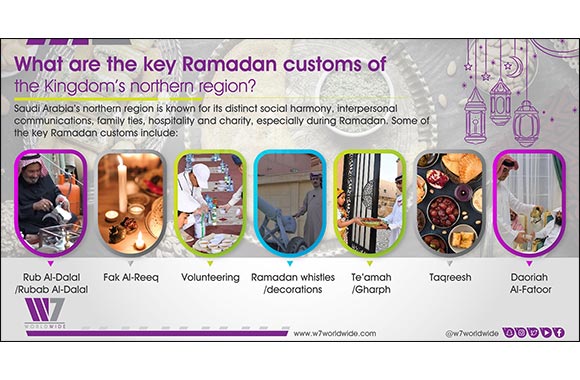Saudi Arabia is a culturally rich society, with each of its regions boasting its own traditions and customs. These social mores become all the more peculiar during Ramadan when people are more socially active and the bonds of brotherhood are even more visible.
The Kingdom’s northern region is no different, where residents indulge in their distinct social harmony, interpersonal communications, family ties, hospitality and charity, especially during Ramadan.
In this blog, W7Worldwide lists seven of the most notable Ramadan customs of the northern region:
1. Daoriah Al-Fatoor: A unique social custom during Ramadan is the practice of hosting periodic iftars, representing the epitome of hospitality in the region. Families get together to organize collective iftars all throughout the month, with each household taking turns preparing the table for everyone. The tradition is expanded to include non-family members as well. Many are eager to host the most lavish iftars, competing with one another to invite as many people as possible. This is because of their belief that doing so brings rewards, helps reconcile hearts, develops communication, and strengthens bonds between relatives, neighbors and friends. During the last 10 days of the holy month, people tend to gather together more frequently, often dressing in their traditional best, and reciting the Holy Qur’an together. Women adorn their hands with henna and dress up for the occasion.
2. Taqreesh: It is an age-old tradition, which involves a feast held on the last day of Sha'ban, or on the eve of Ramadan. Families prepare delicious food and traditional sweets during Taqreesh, which is held separately for relatives, neighbors, and friends on three different days. These gatherings serve as a social celebration for both young and old. People exchange stories, reminisce about the days gone by, and enjoy each other's company in preparation for the holy month. Dressed in traditional clothing such as jalabiyas and thobes, both men and women show their excitement and joy in welcoming Ramadan.
3. Te’amah/Gharph. Sharing iftar meals and popular Ramadan dishes among neighbors and acquaintances is another tradition, which serves to strengthen the bonds between people and reflects the significance of cooperation, mutual support, and gratitude towards one another. The sharing of food in communal spaces is a common feature of Saudi culture, with different regions giving rise to similar scenes in neighborhoods just before breaking the fast. This tradition represents the interdependence between people and underscores the importance of helping others.
4. Ramadan whistles/decorations: The people of the north reminisce the use of Ramadan cannons and whistles during the 60s and 70s to signal the start and end of fasting. The whistle, resembling the sound of the civil defense whistle, was loud and used to notify people about the time to break their fast. Today, while the cannon and the whistle may not be in use anymore, people in the north have still kept many other traditions alive. Around Maghrib, the streets are dotted with stalls selling various Ramadan delectables, vegetables, fruits and juices, attracting hordes of people. The streets and markets are adorned with colorful lamps and decorations to mark the festive mood. Women and girls can be seen dressed in their traditional attires to express their joy for Ramadan.
5. Volunteering: Saudi society, in general, is big on charity, and the northern region is no less. Following the example of the Prophet Mohammed (peace be upon him), people tend to become more generous in Ramadan. Here, many young men and women involve themselves in voluntary work, which could be anything from hosting iftar programs to distributing Ramadan baskets and gifts to the needy and deserving.
6. Fak Al-Reeq: A common practice in this part of the Kingdom as may be in other places as well is to break the fast with just dates and water, and pray first before consuming the rest of the meal. Their iftar servings include light foods like soups and juices. Meanwhile, some like to finish their iftar completely before praying. A popular dish called “Iqt” made with ghee and milk is consumed during iftar. The dish is also known as 'Jameed,' 'Al-Madir,' or 'Al-Baqel.'
7. Rub Al-Dalal/Rubab Al-Dalal: One Ramadan tradition that is also observed in Sha'ban, is where the 'rubab' sets up a tent to welcome guests. The rubab takes care to clean, polish, and whiten the silver metal buckets used to serve coffee to guests. These buckets hold special significance and are highly appreciated, particularly among the owners of grills and majlis. They are typically used to serve coffee alongside dates as part of the Ramadan meal.



